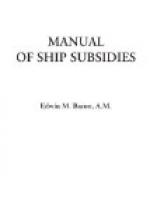By subsequent acts the secretary of the navy was authorized to advance twenty-five thousand dollars a month on each of the ships called for by these several contracts from the time of their launching to their finish; and the date of the completion of the first Collins steamer and the opening of the New York and Liverpool service was extended to June 1, 1850.[GE]
At the same time that the secretary of the navy was executing these contracts the postmaster-general under the authority of an act “to establish certain Post Routes and for other purposes,” also approved March 3, 1847,[GF] was contracting for a steamship mail-service between Charleston and Havana, with a subsidy of forty-five thousand dollars per annum. This contract was entered into with M.C. Mordecai of Charleston, who agreed to furnish steamships suitable for war purposes, and to perform a monthly service.[GG] Several other propositions for steamship service to various foreign countries were made to the postmaster-general at this time, but none was accepted.[GH]
The pioneer Bremen-Havre line began its service on the first day of June 1847, with two steamers. These were the Washington and the Hermann, built in New York, strong and large, of 1640 tons and 1734 tons, respectively, side-wheelers, bark-rigged. At first they made the run to Bremen in from twelve to seventeen days, much better time than the average clipper.[GI] But up to 1851 they had no regular schedule of sailings, and, their speed being unsatisfactory, few mails were sent by them. The subsidy payments, therefore, were made for each voyage separately.[GJ] They had also ceased to command the patronage of travellers. Nevertheless, as a committee of the Senate in 1850 reported, they were believed to have been “profitable to their owners as freight vessels, and of essential service in promoting the interests of American commerce."[GK] The full service, with twelve trips to Bremen and twelve to Havre, was finally begun in 1851, when two more, and larger ships,—the Franklin and the Humboldt, each of 2184 tons, were added to the Havre line. Four years before, the original company, because of financial difficulties, had organized a separate corporation for the Havre service. In 1852 Congress extended the contract to 1857;[GJ] and Southampton was made the point of shifting the mails.
The New York and Chagres, the Charleston and Havana, and the Pacific line, were all under way before the close of 1848. The Pacific line was the first in operation. The service began with the three steamers called for by the contract, the first sailing from New York on the sixth of October, the other two early in December. They were the California, 1050 tons, the Panama, 1087 tons, the Oregon, 1099 tons, all built in New York. The New York and Chagres line was started also in December with the sailing of the Falcon, 1000 tons, a purchased steamer which the Navy Department accepted temporarily, while the new ships were building, that the service might be immediately begun. The opening of the new territory south of Oregon acquired through the Mexican War, and the beginning of the rush of the “Argonauts” to the newly discovered gold fields of California, had made all concerned anxious to get these connecting steamship lines a-going.




